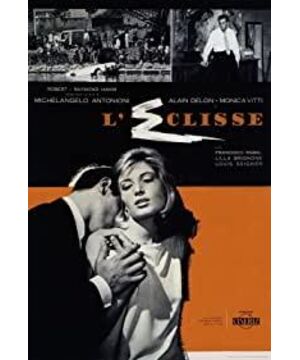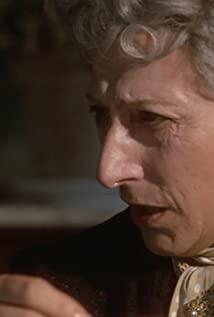"The Sea of Desires" ("Eclipse") filmed after "Adventures" in 1960 and "Night" in 1961 is my favorite movie because it has the kind of desire that only a few classic movies have. The temperament makes you want to watch it again and again, and each time you will have a different harvest. The supremacy of the sense of form in "The Sea of Shame" does not mean sacrificing the story. Antonioni's greatness lies in that he did not dissolve the story, but that he "structured" the story and turned it into a plot. In other words, events and events in traditional movies are related to each other, drawing the attention of the audience, forming a complete "story", but in Antonioni, events and events become unrelated, and they are shattered. The audience will feel unfamiliar with the characters and lose the desire to explore the plot, so they will focus on emotions and see how the director can create a wonderful story in a limited plot. Emotional experience. Modern movies are completely different from traditional movies in terms of rhythm, scale, sound, and feel. Therefore, Antonioni is worthy of being the "person who stole the neo-realistic bicycle."
If it is a rare experience to express the splendid plot of a traditional movie in words, it has become a test for modern movies. Because like all abstract art styles pursue, feeling is far more important than visibility. Just like the first scene of "The Sea of Mime", it is an extremely wonderful formalism exercise. Objects, characters, and sounds together make up an unforgettable artwork. The relationship between Victoria and Ricardo, played by Monica Witty, is broken, and they have to face the difficult moment of breaking up. From the very beginning, what Antonioni presented to the audience was the ending of a relationship, and this still needs to be grasped by the audience, because when the film enters this plot, it starts with the details of the object of a lamp, and there is no dialogue between the characters for a long time. When watching Antonioni's movies, there is always only one unchanging rule, that is, there is no absolute protagonist. The core of the movie is not a single person, but his interaction with the surrounding environment. This is why the first shot of the film is a lamp (corresponding to the last shot of the film, it is also a lamp, which seems to be a deliberately designed reincarnation and hint). In this passage, we see that Ricardo's room is full of modernist paintings, and Antonioni even gave them more shots than characters. Victoria was fiddling with the small objects on the table, and it was behind a frame that was propped up, when the camera suddenly cut to the other side, the sculpture looked different. After a long silence, there was another time-consuming dialogue: "Do you still feel about me?" "How long did it start?" "I don't know", full of indescribable boredom. Victoria started to move, but Ricardo sat stiffly on the sofa like a dead body, the figures juxtaposed with various geometric figures, the smooth floor and the mirror on the wall reflected the double-sided Victoria, and the rotation of the electric fan was lingering. Go, it's boring. This three-dimensional sense of division is as interesting as Picasso's paintings. Immediately afterwards, we saw Victoria opened the window, and an oil refinery tower shaped like a mushroom cloud appeared outside the window. The space continued to be expanded. We saw the most direct symbol of Italy’s post-war economic take-off in the 1960s. This city has just experienced At the glorious moment of hosting the Olympic Games in 1960, a new era emerged, with new lifestyles, new values, and of course new sorrows, just like Victoria at this moment.
In "Adventure" and the subsequent "Red Desert", Monica Witty played very similar roles. They both retain the childlike innocence but bear a heavy sadness. Monica Witty was able to complete this transition in just a few seconds (such as looking for a dog later), which is why Antonioni likes her so much. The emotional transition in "The Sea of Shame" is full of suddenness. Antonioni likes to use sudden and sharp voice-overs to transfer the dialogue. What is even more exciting in "The Sea of Mummy" is the sudden shift of space. For example, Victoria, who walked alone in an empty street after breaking up with Ricardo, suddenly appeared in the next second. The noisy Rome Stock Exchange. The three clips of Victoria and Pierrot at the end of the film are even more exciting. Antonioni relied on this "obsessive-compulsive" editing method to make the film fragmented. We can easily see that the characters appearing in the plot are Victoria and Ricardo-Victoria-Pierrot-Victoria. And Pierrot-Victoria-all disappeared. This is Antonioni bluntly telling the audience all the development of the plot, but he is unwilling to say what is implicit in it.
Antonioni focuses on the communication between people and the interaction with the environment. Victoria looks for the meaning of life in the objects in the frame, while the director has to find his own aesthetic organization in the contemporary world where the characters live, so Antonio Ni's meticulously constructs every picture, and no one inch of film is not serving art. So what kind of world is this? As mentioned earlier, the economic development of Italy in the early 1960s gave birth to changes in all aspects of the era. Victoria is like the incarnation of Antonioni. She is confused in this new world and finds the disintegration of the traditional family (mother is addicted to stocks, family The happiness only exists in the picture frame), religion is absent (the church becomes the background, the priest becomes the passerby), the world is enveloped by the threat of nuclear weapons (mushroom cloud-like oil refinery tower, passers-by are holding the words "Nuclear Age" and "Peace" at the end "Dead" newspaper), Europe is also experiencing the final period of colonialism (Kenya, the last British colony in Africa is undergoing a vigorous independence movement), Antonioni even arranged a large number of scenes to show (Victoria’s neighbor was once Kenyan colonists). Pierrot is the spokesperson of this era. He is engaged in the emerging profession of stockbrokers. He seems to be calling for trouble, but he is just a small person in this huge economic system. The rise and fall of stocks are controlled by the political parties. The encounter between Victoria and Pierrot is like a collision between tradition and modernity. They are both attracted to and guarded against each other, unable to fully engage in this new love affair. The theme of this movie by Antonioni can be said to be "how the disappeared protagonist can find contact with the world". We see Victoria shuttled in one space (Ricardo’s apartment, stock exchange, own apartment, mother’s apartment, Pierrot’s parents’ apartment, Pierrot’s office), and the movie is in every space. Implying the impossibility of this connection: the phone rang, but no one answered; the characters were always crossing various obstacles (doors, windows, aisles, fences); Pierrot and Victoria kissed through the glass twice (isolated) And distrust); objects (including various buildings) separate the sight of the characters (the huge column in the stock exchange hall separates Victoria and Pierre). The indifference in this kind of space expresses Antonioni's core views. In modern society, everyone has their place, but they often cannot find their place.
Under the theme of space supremacy, the protagonist has gradually disappeared, and some "irrelevant" characters (Victoria's racist neighbor, stock market loss-making investor, and alcoholic who stole Pierre's car) often appear in the movie. People want to get a glimpse of their stories. At the end of the film’s shining history, the scenes and characters that have appeared in the film once again appear, but the carriage, trees, nurses, zebra crossing, building materials, and buckets are all there, only two. The protagonist is absent, even two of them are very similar to Pierre and Victoria, but they are not the characters we expect to appear after all. So far, countless movie fans have given countless interpretations of this ending. Does it mean that the two will never see each other again? Or is it the environment of the new era and the lost humanity? In fact, this is precisely what Antonioni excels. The essence of poetic abstraction is here. The final interpretation right is given to the audience, and everyone has the most reasonable interpretation.
The love in Antonioni's movies is always cold and full of asceticism. Perhaps as he said, "Love is a poison in modern society and cannot appear in a normal way." Victoria always had a kind of alienated rejection in her interactions with Pierrot, but she couldn't help calling him when she was separated. In the three wonderful scenes in the second half of the film (Pierre's parents' home-next to the outdoor church-Pierre's office), emotions are not strengthened step by step, become strong, nor are they growing step by step. Weakened, become alienated, but full of restraints, it feels like there is always something between two people, and intimate behavior is often hindered by external forces. Victoria embodies the "floating sense of nothingness" that is the core character in Antonioni's films. She seems to have found a connection with the world the moment she enters Pierre's parents bedroom, but family happiness is far from what modern society pursues. Value, they indulge in emotions and desires, unable to maintain that fragile balance. Pierre looks like a fish in water at work, but he actually lives by lies and acting. He is young, but prefers to hook up with prostitutes on boring nights. Whether it was Victoria or Pierre, they were trying to escape the boredom of life, but in the end they only found boredom again. Antonioni cleverly edited these three paragraphs like jumps and jumps. Time disappeared. The audience had no idea how their interactions were progressing. They were like passers-by who were drifting away from us, becoming more and more unfamiliar. Finally disappeared completely. It is also worth noting that the performance of "sex" in Antonioni's films is often in a missing position, just like Pierre and Victoria have just started making love, and the scene immediately cuts to their outdoor scenes. Antonioni sees sex as a way to establish a path with reality (in "Red Desert", Juliana has a physical relationship with her husband’s friends in order to truly integrate into the world; in "Night" the husband and wife’s reconciliation finally It also ends with sex on the grass), it is more mysterious and thorough than love, and it can't just be expressed as a material comfort, but when the conditions for communication no longer exist, sex becomes their only means of communication. . In "The Sea of Shame," we are not even sure whether this has actually happened? When Victoria and Pierre bid farewell to his office at the end, they looked in different directions when they hugged each other. This was a heartbreaking moment. Victoria was reluctant to leave in the corridor for a long time, and Pierre let him go. After finishing all the calls, sitting at the desk and devoting to the hypocritical work, Victoria finally had the courage to leave. She went out, and we found that this was where Pierre had hooked up. The place where the prostitutes were set up was taken at a completely opposite angle to the previous shooting angle, and the shot passed through the carved iron windows and fixed on the lush trees. You really can only feel the emotions in this time and space by yourself. This is a completely irrational and subjective visual effect. Such beautiful visual images always appear in Antonioni's movies, making people seem to walk into an empty space. In the desert of emotion, ignore all the repression of morality and rules in reality.
There is also a classic image in "The Sea of Shame", that is, when Pierrot's car stolen by a drunkard is salvaged, the hand of the dead drunk who stretched out the car window is so feeble, but it happens to be the same as Victoria When the eyes meet, it is like a call, heralding the ultimate fate of this thriving world. It is the last connection between this person and this world. This chilling image seems to be telling the most poetic loneliness of this era. .
View more about L'Eclisse reviews











